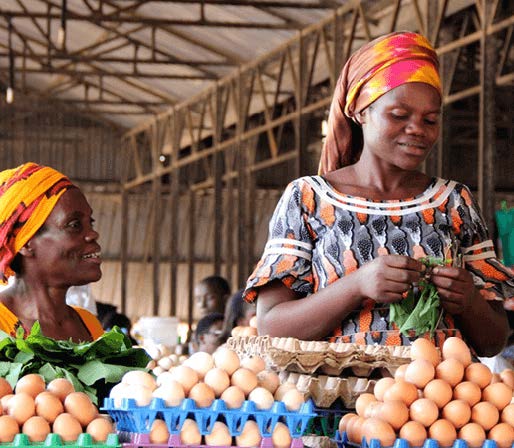Source:
FSD Zambia
According to the FinScope (2020) Survey findings, the increase or growth in the Zambian financial inclusion is mainly attributed to increased uptake of mobile money which registered an increase from 14% in 2015 to 58.5% by 2020. Financial Products or services means a product or service related to finance, including banking, securities, consumer credit, or money transmission. By enabling poor households to use products and services of formal financial institutions to optimally maintain accounts, they will have better access to financial products such as:
- – Payments
- – Savings
- – Credit
- – Risk Management tools such as insurance
A critical look at the factors of financial inclusion reveals why each of them is necessary
Payments
Financial inclusion starts with payments. They serve as a gateway to other financial services. Mobile money payments in Zambia have grown to an annual average of 126% in value, from K2.07 billion in 2015 to K452.0 billion in 2023. To improve financial inclusion, these transaction accounts need to enable end users to meet most, if not all, of their payment needs and to safely store some value.
Savings
Savings are also an important aspect of financial inclusion. The emergence of mobile money banking services has been seen as a blessing to many low-income earners in Zambia.
Luke Bwalya is a 27-year-old informal trader in Lusaka, the Zambian capital, who has never opened an account with any bank since he started his business of selling various merchandise. According to him, banks are for people with a lot of money. Savings are important for smoothing out peaks and troughs in income and expenditure. The poor do save using mainly informal sector financial services and that savings have an impact on poor people in three key areas being;
(1) Wealth accumulation to finance a household’s long-term goals
(2) Insurance against illness, death and sudden income losses and other contingencies;
(3) Safeguard against uneven income streams due to seasonal variations
(savings of high-income periods are used to finance consumption expenditures during low- income periods); and
(4) Savings for future investments in education for children and other human resource development investments. Mobile money electronic accounts offer the safe storage of cash, though without the payment of interest. Savings on a mobile money platform has been made much easier as mobile money agents are found.
Credit
Improving credit access in Zambia is key to not only increasing formal financial inclusion but also to growing and developing Zambia’s ever-changing economy. Access to credit for Zambian household enables poor people have assets they need to transform to economic empowerment, access capital for SMEs and help pay school fees. However, credit should be well regulated otherwise the burden of it can render it useless. Zambians are using SGs to access credit and this has shown that closer user SGs experience more trust that microfine.
Digital credit has become quite popular for women and all other customers on mobile money platforms. From the credit exposure algorithms determined over data on mobile money, a service provider can advance a determined amount to a user. This is faster access to credit and goes a long way to supporting women businesses.
Insurance
Insurance is one of four pillars of financial inclusion. Insurance products can make a significant positive difference in the lives of vulnerable individuals by helping households mitigate shocks and improve the management of expenses related to unforeseen events such as medical emergencies, a death in the family, theft or natural disasters. However, there is a persistent insurance gap, particularly in developing countries. Insurance is one of the least used financial services, meaning low-income households and individuals are needlessly vulnerable to risk and financial shocks.
Zambia is no exception; current insurance penetration is very low, aside from mandatory insurance such as motor vehicle cover, still skewed towards high-income population segments. Inclusive insurance is recognized as a valuable means to stabilize and even improve income for individuals, households, and businesses. It can be used alongside credit, savings, and transfers to mitigate and financially relieve the potential financial losses faced by middle or low-income individuals and micro, small and medium sized enterprises (MSMEs). These include health, disability, and accident-related risks, or the death of a family member. Insurance can also protect assets including houses, livestock, or vehicles, against the repercussions of theft, fire, death, loss, or the impacts of natural disaster and climate change. It is widely recognized that, over time, inclusive insurance can improve welfare. It builds financial resilience, cushioning individuals, households, businesses, and communities from economic shocks, preventing them from falling into poverty or becoming poorer.
All the above financial products give women basic tools they need to prosper in the economy. Without them, women can struggle to start businesses, save to match earnings to their cost payments over time, invest in the future, and provide for their families. Closing the gender gap in DFI will have positive effects.
Having better access to and use of a range of financial services also contributes to women’s autonomy, allowing for better use of their personal and household resources, and reducing the vulnerability of their households and businesses. In a nutshell, increasing financial inclusion for women can act as an enabler of countries’ development, economic growth, inequality reduction, business evolution, and social inclusion.
How to grow women’s access for financial services in Zambia
The plan to achieve greater women’s financial inclusion is dependent upon the creation of a more gender inclusive financial system that addresses the specific demand and supply barriers faced by women, supported by an inclusive regulatory environment.
Factors necessary for the achievement of full digitized financial inclusion
Access to financial services is a prerequisite for uptake and usage of services. There are various reasons for the lower uptake of financial services by women. The three most important ones are access to cell phones, digital financial literacy, and KYC rules.
According to a wide range of research available, including FinScope 2020 and the ZICTA Survey 2018, many women do not have mobile devices that can enable them to access DFS. Data shows that about 40% of women do not have cell phone access. FSD Zambia’s recent work to distribute cell phones and solar mini chargers to women found that they were extremely enthusiastic and empowered to expand mobile money services and knowledge.
Low levels of financial literacy among women discourage even owners of mobile phones to utilise them for different types of transactions. In some countries of the sub-Sahara, deliberate programs have been designed to send young people into communities to teach women and older citizens how to operate a mobile hand device.
FSD Zambia undertook a pilot community radio programme for digital financial education called Bank Yako in Eastern Province and showed significant results, particularly for women.
Many women do not have the formal identification documents to meet the requirements for Know Your Customer (KYC). This becomes a problem as women begin to move from informal financial services to formal ones. Most women will not remember where their one acquired paper-based National Registration Card (NCR) identity card is stored. Implementation of an electronic/biometric identity system is a good solution for this complication, and development of the approach is well under way in Zambia.
Once these barriers of cell phone access, digital literacy, and identity are addressed, the issue of the right financial product to attract women becomes more immediate. Many financial services providers do not work out client-centric product development when it comes to serving women. Since their products and services are only superficially tailored to meet men’s needs, most women remain un-served as they do not find reasons justifying use of existing financial services. Service providers must avoid gender-neutral approaches, adopt gender segmentation during research and product design, and articulate a clear business case for reaching underserved women.





